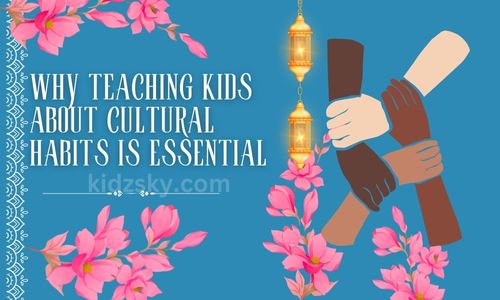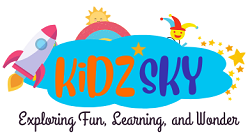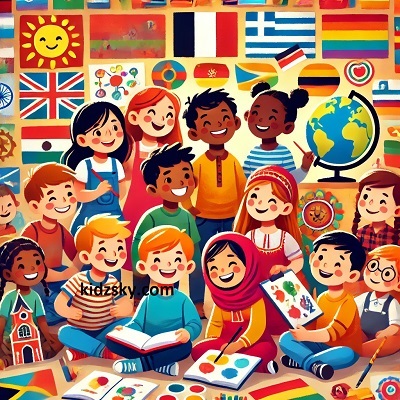Teaching kids about cultural habits has become more critical in our increasingly diverse world. Exposing children to different customs, values, and traditions, we help them develop empathy, curiosity, and understanding.
This blog will guide you through teaching kids about cultural habits with practical activities, examples, and tips for instilling a sense of respect and appreciation for global diversity.

Why Teaching Kids About Cultural Habits is Essential
Understanding cultural habits is more than just learning facts; it’s about building the skills for respectful and positive social interactions. Here’s why teaching kids about cultural habits is essential:
- Builds Respect: Kids learn to appreciate differences and respect diverse beliefs, customs, and traditions.
- Encourages Open-Mindedness: Exposure to various cultures helps children see the world through multiple perspectives.
- Develop Social Skills: Children learn to communicate effectively with people from different backgrounds by understanding cultural differences by understanding cultural differences by understanding cultural differences.
- Fosters Global Awareness: A knowledge of cultural habits builds a foundation for future learning and exploration.
Steps for Teaching
Let’s introduce a few practical ways to teach kids about cultural habits.
1. Start with Your Own Culture
Before exploring other cultures, it’s helpful to begin with your own. Kids need a foundation of understanding their culture to appreciate others.
- Celebrate Traditions: Engage in traditional activities, festivals, or customs to create a sense of identity.
- Share Family Stories: Talk about family history or stories highlighting unique cultural values.
- Cook Traditional Foods: Preparing traditional dishes together can introduce kids to cultural habits surrounding food.
2. Introduce Cultural Books and Stories
Books are a fantastic tool for teaching kids about cultural habits. Choose age-appropriate stories from different cultures to introduce new perspectives.
- Example: Books like “Children Just Like Me” by DK Publishing or “Last Stop on Market Street” by Matt de la Peña give insights into diverse lifestyles and traditions.
- Activity: After reading, discuss the story’s cultural aspects with questions like, “What was different about the character’s life?” or “What new tradition did you learn about?”
New Blog:- Kids Educational Activities at Home: 10 Perfect for Holidays

3. Encourage Learning Through Music and Dance
Music and dance are universal languages and excellent methods for teaching kids about cultural habits.
- Listen to Global Music: Play songs from different countries and discuss the instruments, rhythms, and lyrics.
- Try Cultural Dances: Look up simple dance moves from various traditions, like salsa from Latin America or Irish step dancing.
- Create Playlists: Curate a playlist of music from around the world, adding songs representing different cultural traditions.
4. Explore Cultural Festivals and Celebrations
Celebrations are rich in tradition, offering a fun way to introduce kids to cultural practices and rituals.
- Attend Local Events: Many communities host cultural festivals. For example, Diwali celebrations, Chinese New Year parades, or Indigenous Powwows are often open to the public.
- Recreate Festive Activities at Home: Even if you can’t attend an event, you can still honor traditions. For instance, lanterns can be made for the Mid-Autumn Festival, and candles can be lit during Hanukkah.
- Learn the History: Talk about the origins and meanings behind each festival to help kids appreciate the cultural significance.
5. Make Use of Technology
With so many online resources, teaching kids about cultural habits has always been challenging. Use apps, websites, and videos to bring cultural education to life.
- Virtual Museum Tours: Many museums offer virtual tours focusing on global cultures. The British Museum, for example, has exhibits on ancient civilizations worldwide.
- Educational Apps: Apps like Duolingo or Khan Academy Kids provide interactive learning for languages, arts, and cultural studies.
- Videos and Documentaries: Short or educational videos can show real-life examples of cultural practices.

6. Create Cultural Art Projects
Art is an excellent way for children to explore other cultures hands-on. Through crafts and projects, kids can learn about artistic traditions worldwide.
- Origami from Japan: Introduce Japanese culture by learning the art of origami. Kids can create paper cranes and learn about the importance of this practice in Japanese history.
- Aboriginal Dot Painting: Try Australian Aboriginal dot painting and explain how this art form is used to tell stories.
- Henna Designs from India: Show examples of Indian henna designs and let kids try drawing similar patterns on paper or with non-permanent markers.
7. Practice Language Basics
Learning even a few words in another language can be an excellent step in teaching kids about cultural habits.
- Start with Simple Phrases: Teach basic greetings like “hello” and “thank you” in different languages.
- Label Household Items: To build familiarity, label items around the house in a second language, such as Spanish or French.
- Use Language Learning Apps: Apps like Duolingo or HelloTalk can introduce kids to different languages through fun, interactive lessons.
You May Like:- Benefits of Learning Multiple Languages for Kids: 8 Best e.g.

8. Try Traditional Games and Sports
Games and sports from other cultures are a fun and interactive way of teaching kids about cultural habits.
- Kabaddi from India: Teach your kids Kabaddi, a traditional team sport from India that encourages teamwork and agility.
- Peteca from Brazil: Play Peteca, a Brazilian game that uses a shuttlecock-like object and encourages coordination.
- Pick-Up Sticks from Indigenous Cultures: This simple game, originating from Indigenous tribes, involves patience and skill.
Practical Tips for Teaching Kids About Cultural Habits
Here are some extra tips to help you succeed in teaching kids about cultural habits:
- Involve the Whole Family: Make cultural learning a family activity, as shared experiences help reinforce lessons.
- Use Visual Aids: Show maps, videos, or photos to help children visualize different countries and cultural practices.
- Encourage Questions: Kids are naturally curious, so be open to their questions. If you don’t know the answer, explore it together!
- Celebrate Small Wins: Each time your child learns something new about another culture, celebrate that accomplishment to keep them motivated.
Example Activities for Teaching Kids About Cultural Habits
Here’s a quick list of easy activities that are perfect for teaching kids about cultural habits:
- Map Exploration: Use a map to locate different countries and discuss their cultures briefly.
- Family Recipe Night: Pick a recipe from another culture, cook it together, and discuss its history.
- Language Day: Dedicate one day a week to using basic phrases from a chosen language.
- Craft a Cultural Calendar: Create a calendar with global holidays, marking them with simple facts or celebrations.
For Parents:- Importance of Spending Time with Your Kids: 7 Best Benefits

The Benefits of Teaching Kids About Cultural Habits
Teaching kids about cultural habits has a lasting impact on their worldview. Here are some benefits:
- Broadened Perspective: Learning about other cultures teaches kids to see the world beyond their immediate surroundings.
- Improved Social Skills: Children learn to interact positively with people from different backgrounds.
- Enhanced Curiosity: Cultural learning sparks curiosity and encourages lifelong learning habits.
- Greater Empathy: Exposure to other cultures fosters empathy, making kids more understanding and compassionate.
Conclusion
Incorporating cultural education into your child’s life doesn’t have to be complex. Teaching kids about cultural habits can be both enjoyable and rewarding with a mix of storytelling, hands-on activities, and a curiosity-driven approach.
These lessons lay the foundation for open-minded, globally aware individuals who respect and appreciate the diversity around them.
Teaching kids about cultural habits prepares them to navigate our interconnected world with understanding and respect. So dive in, explore, and enjoy the journey of artistic discovery with your children.
This shared learning will create lasting memories and instill values that will stay with them forever.
Admin creates all Photos used in this blog in Canva.





Pingback: Creating a Family Reading Corner: 5 Step-by-Step Best Guide
Pingback: The Benefits of Gardening with Kids: 7 Skills & Fun Together